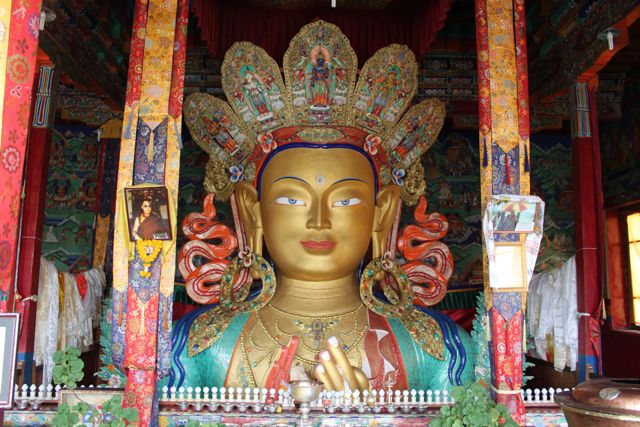Continued from here:
There was no meal waiting for us when we reached Likir. Instead, we found a deserted courtyard, the monks having taken shelter inside their rooms, I assumed, against the sudden downpour. From a distance, we could barely make out the shape of the large Buddha statue, imposing yet benign, smiling down upon the verdant valley. Inside the shrine, a couple of monks were chatting with a tourist guide who had got along a French couple. They looked through the shrine with great concentration, stopping to photograph every mural on the walls. The original site held a gompa built in the early 11th century which was destroyed in a fire and rebuilt in its present form in the 18th century.

The rain had fortunately stopped the next day when we made our way to Alchi close to Likir, a sleepy hamlet of population just over a thousand and now a hot favourite of backpacking tourists. Our driver dropped us by the entrance to the temple complex promising with a wide grin, “You do not have to climb steep steps for this one”. Ah, the small mercies of life; Alchi, unlike other gompas is not perched on a hill but sits in a valley, quiet and self-effacing. The drab exteriors of this temple complex do not reveal in any way the treasures hidden inside.

Apart from an array of clay statues of the Buddha, the highlight of the Alchi gompa is the 1000 year old wall paintings. These paintings are of a distinct Indian (Kashmiri) style, different from other gompas in Ladakh and do not carry much of the typical Tibetan iconography. It is believed that the Alchi complex was abandoned in between and remained unknown till it was unearthed a few decades ago – maybe its anonymity has helped preserve the art work inside. Great care is taken today to ensure that visitors do no desecrate the wall paintings in any way. Indeed, the grouchy caretaker who sold us the entrance tickets outside followed us inside just to ensure that we did not take a single photograph. And so I went back to shining my torchlight (highly recommended, given the unlit interiors) over the hundreds of tiny Buddha paintings all along the walls, willing my eyes to get accustomed to the darkness faster.
From Alchi, we headed on towards Lamayuru in the Western Kargil district. A mere nine kilometers before Lamayuru, we were stopped and turned back by a massive landslide that had blocked the narrow mountain road. However, I was sure that Lamayuru I must see; in a piece for the New York Times, famed travel writer Pico Iyer says of it that a gasp escaped his (jaded) lips when he first set eyes on the gompa.

And so we returned on a sunny day, up, up the winding mountain road, cleared of all landslides. Each time I wanted to stop for photographs, our driver urged us on, “further ahead is more beautiful, it is called moonscape”. Moonscape, the word rolled off his tongue easily, having, I guessed, rolled off a thousand tourist tongues earlier.
Lamayuru is believed to be the first monastery to be set up in Ladakh. The story is that there was a massive lake at the present location of the gompa, whose waters dried up on the behest of Mahasiddha Naropa, an Indian pilgrim in the late 10th century. The gompa, it is said, initially consisted of five buildings, although only one of them stands intact. It is still one of the largest monasteries in Ladakh, housing over 150 permanent monks.


On the way back to Leh, we made a quick detour to Basgo, the underdog not very popular on the tourist circuit. Once the seat of power of the Namgyal dynasty, the palace castle is in complete disrepair now. Basgo today deserves a mention, if only for its stunning location. It sits high up on a crag in solitary ruin, just a signboard to indicate to the more susceptible tourists the grandeur that must have once been.


No monks were visible as we walked into the complex and we had to walk up the maze-like corridors to the terrace to fetch a sleepy watchman to open the rooms for us. Basgo has an impressive statue of Maitreya, the future Buddha, along with murals dating back from the 16th century. Standing on the terrace, we could see for miles – at a distance, we spotted a convoy of Indian army trucks creeping past on its way to Srinagar, little green ants carrying goodies back to their nest.
(Monasteries of Ladakh – more to come)



2 thoughts on “On the monastery trail in Ladakh-2”